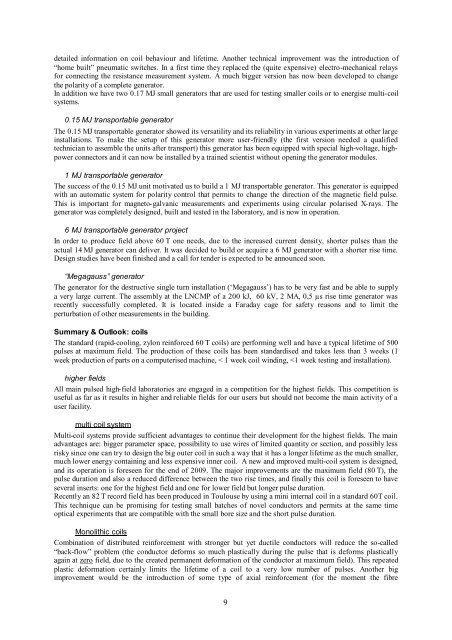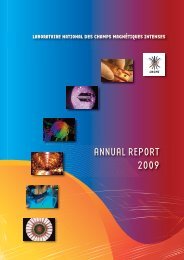Laboratoire National des Champs Magnétiques Pulsés CNRS – INSA
Laboratoire National des Champs Magnétiques Pulsés CNRS – INSA
Laboratoire National des Champs Magnétiques Pulsés CNRS – INSA
Create successful ePaper yourself
Turn your PDF publications into a flip-book with our unique Google optimized e-Paper software.
detailed information on coil behaviour and lifetime. Another technical improvement was the introduction of<br />
“home built” pneumatic switches. In a first time they replaced the (quite expensive) electro-mechanical relays<br />
for connecting the resistance measurement system. A much bigger version has now been developed to change<br />
the polarity of a complete generator.<br />
In addition we have two 0.17 MJ small generators that are used for testing smaller coils or to energise multi-coil<br />
systems.<br />
0.15 MJ transportable generator<br />
The 0.15 MJ transportable generator showed its versatility and its reliability in various experiments at other large<br />
installations. To make the setup of this generator more user-friendly (the first version needed a qualified<br />
technician to assemble the units after transport) this generator has been equipped with special high-voltage, highpower<br />
connectors and it can now be installed by a trained scientist without opening the generator modules.<br />
1 MJ transportable generator<br />
The success of the 0.15 MJ unit motivated us to build a 1 MJ transportable generator. This generator is equipped<br />
with an automatic system for polarity control that permits to change the direction of the magnetic field pulse.<br />
This is important for magneto-galvanic measurements and experiments using circular polarised X-rays. The<br />
generator was completely <strong>des</strong>igned, built and tested in the laboratory, and is now in operation.<br />
6 MJ transportable generator project<br />
In order to produce field above 60 T one needs, due to the increased current density, shorter pulses than the<br />
actual 14 MJ generator can deliver. It was decided to build or acquire a 6 MJ generator with a shorter rise time.<br />
Design studies have been finished and a call for tender is expected to be announced soon.<br />
“Megagauss” generator<br />
The generator for the <strong>des</strong>tructive single turn installation (‘Megagauss’) has to be very fast and be able to supply<br />
a very large current. The assembly at the LNCMP of a 200 kJ, 60 kV, 2 MA, 0,5 µs rise time generator was<br />
recently successfully completed. It is located inside a Faraday cage for safety reasons and to limit the<br />
perturbation of other measurements in the building.<br />
Summary & Outlook: coils<br />
The standard (rapid-cooling, zylon reinforced 60 T coils) are performing well and have a typical lifetime of 500<br />
pulses at maximum field. The production of these coils has been standardised and takes less than 3 weeks (1<br />
week production of parts on a computerised machine, < 1 week coil winding,







